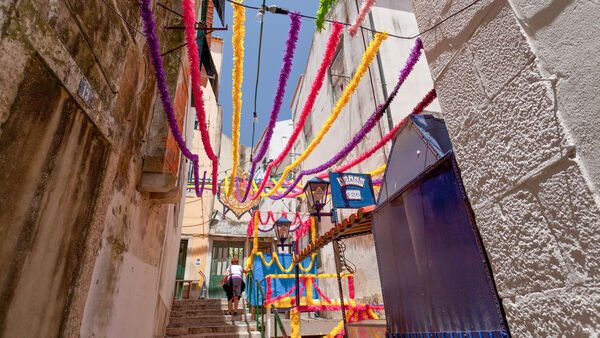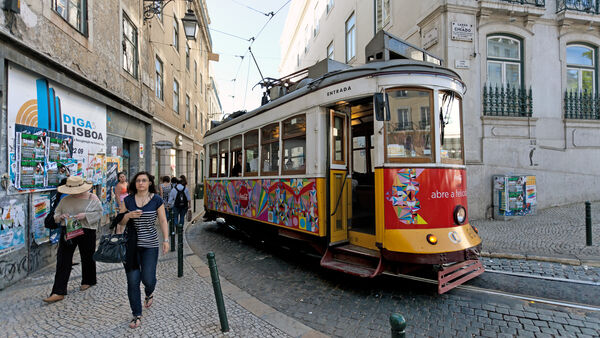Lisbon’s Gold Still Shines


By Rick Steves
Barely elegant outdoor cafés, glittering art, and the saltiest sailors' quarter in Europe, all at bargain-basement prices, make Lisbon an Iberian highlight.
Romans and Moors were the earliest settlers in Lisbon, but the city's glory days were in the 15th and 16th centuries, when explorers opened new trade routes around Africa to India, making Lisbon one of Europe's richest cities. But on the morning of All Saints' Day in 1755, while most of the population was at church, a tremendous underwater earthquake occurred off the southern Portuguese coast. The violent tremors were felt throughout Europe — as far away as Finland. Fires — started by cooking flames and church candles — raged through the wooden city center, and a huge tsunami caused by the earthquake blasted the waterfront and surged up the Rio Tejo.
Two-thirds of Lisbon was leveled. The city was eventually rebuilt on a strict grid plan, symmetrically, with broad boulevards and square squares. But the grandeur of pre-earthquake Lisbon survives in three neighborhoods: Belém, the Alfama, and the Bairro Alto. Follow me through a day exploring the heritage of Lisbon.
After breakfast, grab a trolley or taxi to Belém. This district, four miles from downtown, is a pincushion of important sights from Portugal's Golden Age, when Vasco da Gama and company made her Europe's richest power.
The white Belém Tower, built in pure Manueline style (ornate Portuguese late Gothic) has guarded Lisbon's harbor since 1520. Today it symbolizes the voyages that made Lisbon powerful. This was the last sight sailors saw as they left their homeland, and the first as they returned, loaded down with gold, spices, and social diseases.
Nearby, the giant Monument to the Discoveries honors Portugal's Prince Henry the Navigator and the country's leading explorers. Across the street, the Monastery of Jerónimos is Portugal's most exciting building — with my favorite cloister in Europe. King Manuel erected this giant, white limestone church and monastery — which stretches 300 impressive yards along the Lisbon waterfront — as a "thank you" for the discoveries made by early Portuguese explorers. It was financed in part with "pepper money," a 5 percent tax on spices brought back from India. Manuel built the church near the site of a humble chapel where sailors spent their last night ashore in prayer before embarking on frightening voyages. The "Manueline" style of this giant church and cloister combines late Gothic and early Renaissance features with motifs from the sea — the source of the wealth that made this art possible.
Before leaving Belém, take your taste buds sightseeing at a famous pastry shop, Casa Pasteis de Belém. This is the birthplace of the wonderful cream tart called pastel de nata throughout Portugal, but here is dubbed pastel de Belém. Since 1837 locals have come here to get them fresh. Sprinkle on the cinnamon and powdered sugar, get a café com leite, and linger.
Spend the early afternoon in your choice of Lisbon's fine museums waiting for the setting sun to rekindle the action in the Alfama. A colorful sailors' quarter, this was the center of the Visigothic town, a rich district during the Arabic period and now the shiver-me-timbers home of Lisbon's fisherfolk. The Alfama is a cobbled cornucopia of pre-earthquake Old World color.
Wander deep. This urban jungle's roads are squeezed into tangled stairways and confused alleys. Bent houses comfort each other in their romantic shabbiness, and the air drips with laundry and the smell of clams and raw fish. Get lost. Poke aimlessly, sample ample grapes, avoid rabid-looking dogs, peek through windows. Make a friend, pet a chicken. Taste the branco seco — the local dry wine.
Gradually zigzag your way up the castle-crowned hill until you reach a viewpoint, the little green square called Miradouro de Santa Luzia. Rest here and survey the cluttered Alfama rooftops below you. A block away is Largo Rodrigues Freitas, a square with several scruffy, cheap, very local eateries. Treat yourself to the special: a plate of boiled clams.
If you climb a few more blocks to the top of the hill, you'll find the ruins of São Jorge Castle. From this fortress, which has dominated the city for more than 1,000 years, enjoy the roaming peacocks and a commanding view of Portugal's capital city.
In the late afternoon, for a quintessential Lisbon drink, duck into one of the funky hole-in-the-wall shops throughout town and ask for a ginginha. Sold for about €1.50 a shot, it's a sweet liquor made from the ginja berry (like a sour cherry), sugar, and schnapps. The only choices are: With or without berries (com elas ;or sem elas — that's "with them" or "without them" ) and gelada (if you want it from a chilled bottle). In Portugal when someone is impressed by the taste of something, they say, "Sabe que nem ginjas" ("It tastes like ginja").
End your day in the Old World–feeling Bairro Alto ("High Town"), one of the most charming parts of the city. Designed in the 16th century with a very modern (at the time) layout, the district housed ship workers back when Portugal was a world power and its ships planted the Portuguese flag all around the globe. Stroll between dramatic viewpoints, leafy parks with inviting kiosk cafés, skinny streets lined with fado folk-singing clubs, and a thriving restaurant scene full of traditional places stuffed with character. Or continue on to the nearby Chiado neighborhood, buzzing with trendy restaurants spearheading Lisbon's burgeoning foodie scene — and with the locals out and about, simply enjoying their good fortune to live in this world-class city.

